October 2004
Bryston 4B SST
Stereo Amplifier: Measurements
All amplifier measurements are performed
independently by BHK Labs. Please click to learn
more about how we test amplifiers there. All measurement data and graphical
information displayed below are the property of SoundStage! and Schneider
Publishing Inc. Reproduction in any format is not permitted.
- Measurements were made with 120V AC line voltage with both
channels driven, input gain switch set to 1V, driving the unbalanced inputs unless
otherwise noted.
- Gain, unbalanced input: 28.7x, 29.5dB (with input switch set
to 1V)
- Output noise, 8-ohm load, unbalanced input, 1k-ohm input
termination: wideband 0.260mV, -80.7dBW; A weighted 0.067mV, -92.5dBW.
- Output noise, 8-ohm load, balanced input, 600-ohm input
termination: wideband 0.307mV, -79.3dBW; A weighted 0.083mV, -90.6dBW.
- AC line current draw at idle: 1.0A.
- Output impedance at 50Hz: 0.011 ohms.
- This amplifier does not invert polarity.
Power output with 1kHz test signal
- 8-ohm load at 1% THD: 336W
- 4-ohm load at 1% THD: 528W
General
The Bryston 4B SST is a medium-/high-power solid-state
design with typically wide bandwidth and very low output impedance.
Chart 1 shows the frequency response of the amp with
varying loads. As can be seen, the output impedance, as judged by the closeness of spacing
between the curves of open-circuit, 8-ohm, and 4-ohm loading is quite low. The variation
with the NHT dummy load in the audio range is negligible. Chart 2 illustrates how total
harmonic distortion plus noise versus power varies for 1kHz and SMPTE IM test signals and
amplifier output load. As can be seen, attainable power is greater for the 4-ohm load, as
is usual for most power amplifiers. Total harmonic distortion plus noise as a function of
frequency at several different power levels is plotted in Chart 3. Amount of rise in
distortion at high frequencies is modest -- a good thing. Damping factor versus frequency
is shown in Chart 4. A spectrum of the harmonic distortion and noise residue is plotted in
Chart 5. The magnitude of the AC line harmonics are low for this amplifier. The test
signal harmonics are both even and odd harmonic with the odd harmonics dominating the
total harmonic sum. The higher-order harmonics quickly decline into the noise level.
| Chart 1
- Frequency Response of Output Voltage as a Function of Output Loading |
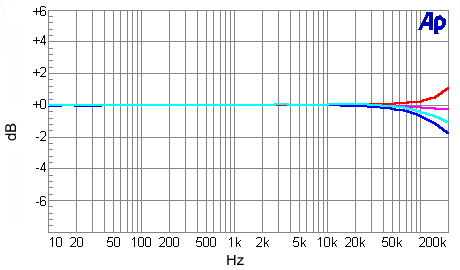
Red line: open circuit
Cyan line: 8-ohm load
Blue line: 4-ohm load
Magenta line: NHT dummy-speaker load
| Chart 2 - Distortion as a Function
of Power Output and Output Loading |
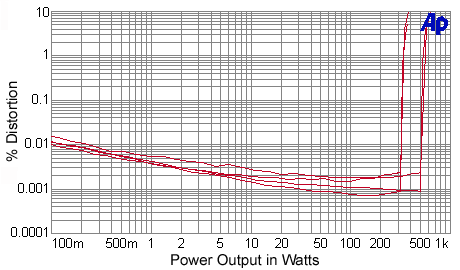
(line up at 10W to determine lines)
Top line: 4-ohm SMPTE IM
Second line: 8-ohm SMPTE IM
Third line: 4-ohm THD+N
Bottom line: 8-ohm THD+N
| Chart 3 - Distortion
as a Function of Power Output and Frequency |
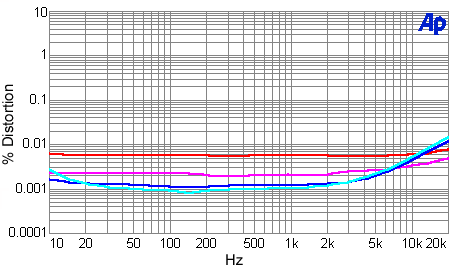
4-ohm output loading
Cyan line: 450W
Blue line: 140W
Magenta line: 20W
Red line: 2W
| Chart 4 - Damping Factor
as a Function of Frequency |
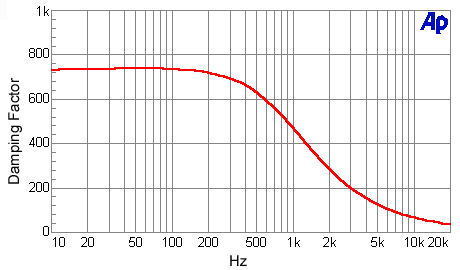
Damping factor = output impedance divided into 8
| Chart 5 - Distortion and
Noise Spectrum |
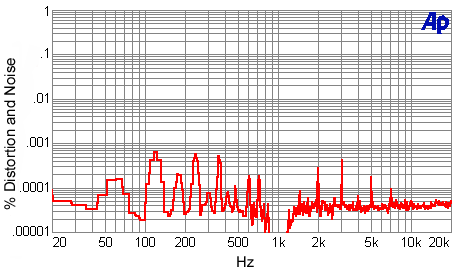
1kHz signal at 10W into a 4-ohm load
|
![[SoundStage!]](../titles/sslogo3.gif) Home Audio
Home Audio ![[SoundStage!]](../titles/sslogo3.gif) All Contents
All Contents



